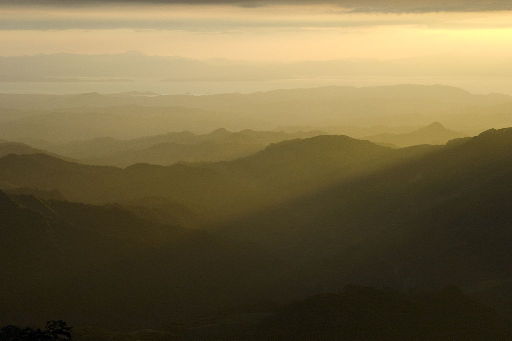
|
| The sunset this day—you can see a full-sized version or a slightly larger one also. |





|
| The sunset this day—you can see a full-sized version or a slightly larger one also. |
For the rest of the day, I didn’t take all that many pictures. You’ll have to check Mark’s page for this part of today for a full account. But below is what I have.

|
| Welcome to El Trapiche (Larger version) |
For lunch and immediately after, we went to El Trapiche, a small organic family-owned coffee- and sugar-plantation.
Our guide was Jairo, a pleasant young man who was a fund of information about the business; lunch had been prepared by his aunt. It was a nice and simple meal: chicken, rice and beans, and a starchy root called arracache (Arracacia xanthorrhiza), celery-like or carrot-like, which to tell the truth did not appeal to me too much—maybe because once I heard its plant family, I thought of my fairly strong allergy to celery root. (If this surprises you, check the “allergy” section of the Wikipedia page on celery.) Salad, naturally, and then Costa Rican coffee, prepared by the sock method, very good as always.
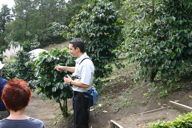
Jairo led us through the sugar-cane and coffee-bush fields, and explained their operation. As I mention above, I took relatively few pictures, preferring, I guess, to listen to his descriptions all that goes into the raising and processing of the two crops they specialize in.
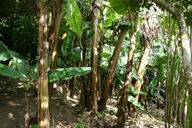
At the left, Jairo is standing surrounded by coffee bushes (large image, small), and at the left is a shot of sugar canes (large image, small). Right around where I took this picture Jairo spotted a two-toed sloth in a tree, and we all peered up to see. I finally caught a glimpse, but it looked like nothing so much as a crude mop. Even Mark doesn’t show a picture of it.
To the right, a shot of sugarcane (large image, small), and all I can say about it is that you can see why working in sugarcane fields must be a very unpleasant job.
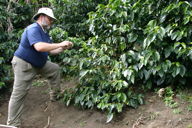
We saw examples of how the ripe cane and the coffee beans were processed; in the case of the latter, it’s an extremely complicated business that definitely can not be fully automated. The beans don’t even all come ripe at the same time, so the pickers have to exercise continual discrimination—not the kind of job you can gather wool during. Mark’s getting a closeup shot of the bushes to the right (big image, small), and I think that you can see, in the larger picture, the sparsity of red beans among the green.
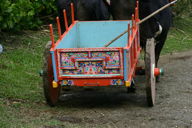
For picturesqueness, El Trapiche had a
traditional Costa Rican ox-cart for us to admire. Very ornately painted,
as you see (large image,
small). The two oxen had it relatively
easy, it would seem: their purpose is mainly to give the tourists a
photo op, and to drive the old-fashioned sugar-press a little ways,
before Jairo or one of the employees unhitches them and then shows
the guests how much quicker it is with a mechanized press.
After El Traphiche, we stopped by a women’s cooperative, where there were all sorts of crafts to be purchased. I think that was where we bought a pound or two of coffee, but the crafts were surpassingly uninteresting. Judy remarked that someone should take the governing committee aside and explain to them that they'll make much more money if they put their effort into making fewer items of much higher quality. You may look on that as norteamericano paternalism, or just an accurate estimate of the clientele’s likely choices in purchasing.
The area owes its character and development to a group of Quakers from Alabama who decided, when the country abolished its army, that Costa Rica was the place for them. Just as you expect Quakers to do, they established all sorts of commercial enterprises, including the Selvatura Park, which turned out to be very successful. From the cooperative, we drove to the area where the Friends have their Meeting and school, and spent time climbing around a huge strangler fig whose original supporting tree has long been rotted away. Mark has pictures of some of us peering out from within.
But then we took a fabulous walk as the dark settled in. Saw a Tucanito, the smallest of all toucans, and realized that there were two, tending a nest with hatchlings, which we could hear. I didn't have my camera with me: it seemed too dark for that. But the target of the walk was to climb a stair to a small viewing platform, where Sergio brought out a bottle of red wine and some glasses. And there was a superb view, very atmospheric, with the ocean in sight, the sun in the process of setting all the while.
And the bus was there, so I could pull my camera out! As a result, I took lots of pictures.
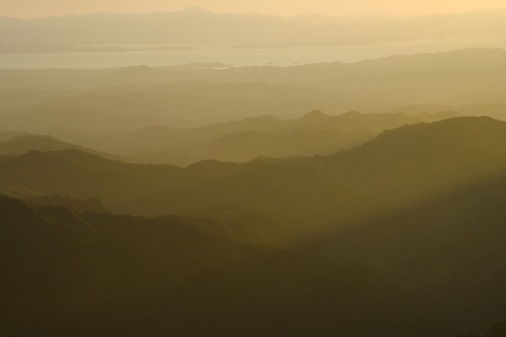
|
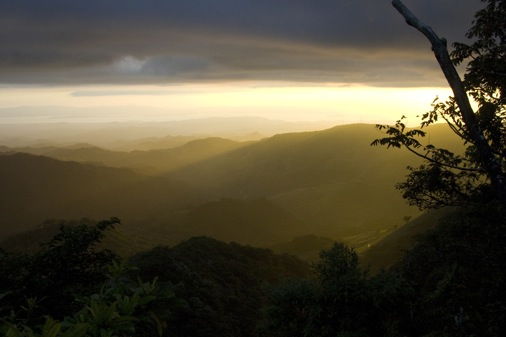
|
| Up at the top, that’s land, not clouds (slightly larger view, full-sized view) | A beautiful end to a fabulous walk (slightly larger view, full-sized view) |
We stood up there enjoying the view and the wine, and enjoying ourselves very much. In the pictures below, you can see all the members of the group except for me and Sergio. At the bottom right, for instance, left to right are Leo, Neal, Lin, Mark, Judy, Sean, and Joan. For these pictures, get the moderate sized version by clicking on the picture itself, and the big version by clicking on the “(+)” beneath.
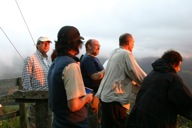
|

|
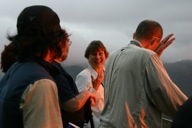
|
| (+) | (+) | (+) |
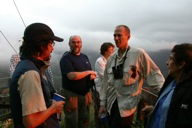
|
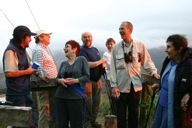
|
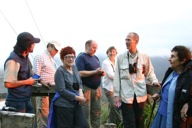
|
| (+) | (+) | (+) |
Dinner was at a very nice restaurant called “Café Taburé”, owned by an Argentine woman, very simpatica. It was next door to the Italian place we had eaten at the night before, and I was much better pleased with this meal than the previous.
But before we ate, Leo had arranged for some simple dance lessons, given by Evelyn Rockwell, a granddaughter of one of the original Quaker settlers that came around 1948 from Alabama after the Costa Rican government abolished the army. And by her friend Haníbal. As usual when it comes down to dancing, I can try, but I never feel at one with the music, nor do I trust that my feet are doing what my brain thinks it’s telling them to.
What I chose for my meal was canelloni, very pleasant, and the rest of the main course I don’t recall. The dessert was a fine flan, not oversweet, with an interesting topping of dulce de leche.
And from there to bed, except…
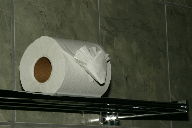
I’m not sure, but I think that this was the first evening that we came back to our room and found the toilet paper folded into the strangest fancy of interior decorating. It’s hard to get a good shot of something that’s completely white. So I had to underexpose the shot seriously—otherwise it would’ve been a white smear. Look at the big version or the small.
We would see much fancier decorations made of TP, and also of towels. But that’s for a later day!
Next day’s pictures; previous installment of this day’s pictures, first installment of this day’s pictures, previous day’s pictures. Return to the central Costa Rica page; to the central travel page; to my home page.